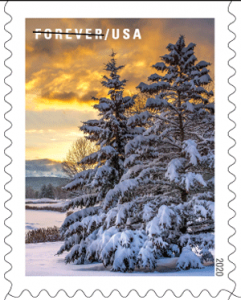[press release]
Royal Mail Reveals its First Stamp Issue of 2021, a Celebration of the Beauty of the UK’s National Parks
- The stamps go on sale 14 January
- The stamps mark 70 years since the first National Parks were founded in the UK
- Today there are 15 National Parks covering 10% of the land area of England, Scotland and Wales
- The stamp set features 10 of the 15 National Parks:
- Peak District
- Lake District
- Snowdonia
- Dartmoor
- North York Moors
- The Broads
- New Forest
- South Downs
- Pembrokeshire Coast
- Loch Lomond and The Trossachs
- Our National Parks contain some of the UK’s most popular landscapes, thousands of ancient monuments and almost a third of our internationally important wildlife sites
- Royal Mail worked with the National Parks on choosing a selection of images to celebrate the anniversary
- The stamps will be available on general sale on 14 January 2021. They will be available at www.royalmail.com/nationalparks, by phone on 03457 641 641 and 7,000 Post Offices across the UK
Royal Mail has revealed images of the first Special Stamps issue of 2021, celebrating the 70th anniversary of the founding of Britain’s first National Parks.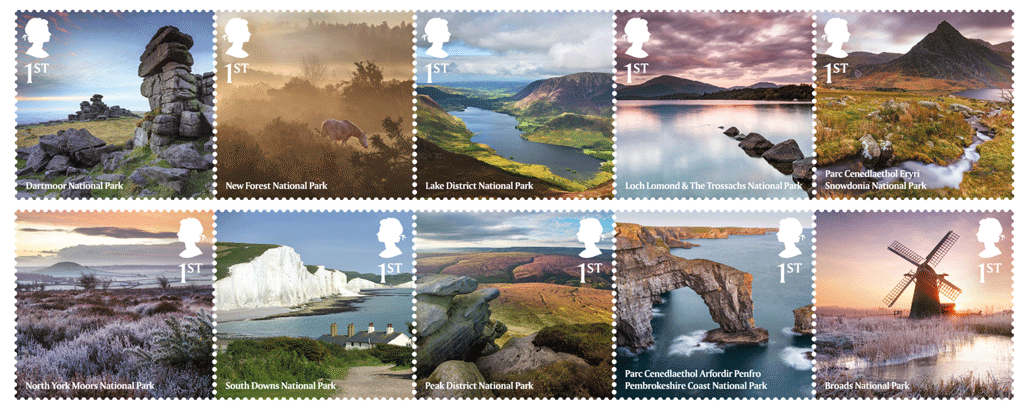
Featuring some of the most UK’s most popular and visited landscapes, the stamp set features 10 of the 15 National Parks:
- Peak District (founded 1951)
- Lake District (1951)
- Snowdonia (1951)
- Dartmoor (1951)
- North York Moors (1952)
- The Broads (1989)
- New Forest (2005)
- South Downs (2010)
- Pembrokeshire Coast (1952)
- Loch Lomond and The Trossachs (2002)
The UK’s National Parks cover a breathtaking range of natural environments: from cold tundra to temperate rainforest, from gigantic sea cliffs to rolling chalk hills, from razor-sharp mountains to marshy wetlands. They are also places where people have lived, worked, worshipped, farmed and traded for centuries, in ways that have shaped — and been shaped by — the surrounding environment. These landscapes are 15 unique combinations of human culture and natural history.
The National Parks were created as the outcome of decades of public effort to open up the countryside to ordinary people. 2021 marks the 70th anniversary of the founding of the UK’s first four National Parks: the Peak District, the Lake District, Dartmoor and Snowdonia. The National Parks are the nation’s ‘breathing spaces’, free for everyone to enjoy regardless of age, background or income.
Today, most of us take for granted the ability to freely enjoy these landscapes, but it was not always so. In the 19th century, the Industrial Revolution turned Britain into the world’s first predominantly urban nation, but people in towns and cities held on to visions of a ‘green and pleasant land’ and found ways of keeping links to the landscapes around them alive through hiking, cycling, rambling and climbing. In the 1870s, the limited access ordinary people had to the countryside gave rise to the ‘right to roam’ movement. The 1932 mass trespass on Kinder Scout in the Peak District proved to be instrumental, galvanising public opinion after five of the young leaders were given prison sentences. The UK’s National Parks, created in the same post-war rebuilding effort as the NHS, are one of the great legacies of this movement. Fittingly, the first to be founded, in 1951, was the Peak District National Park. For all their diversity, the National Parks have one thing in common: they belong to all of us.
Philip Parker, Royal Mail, said: “Ten spectacular National Parks have been captured in stunning photographs that reflect their diversity and splendour. We are proud to be able to share the beauty of these parks on stamps at a time when so many of us have had our travel restricted.”
The stamps will be on sale from 14 January and will be available at www.royalmail.com/nationalparks, by phone on 03457 641 641 and in 7,000 Post Offices across the UK.
Stamp-by-stamp:
Dartmoor National Park
 Dartmoor is a world of high moorland, open space and huge skies. Here is a place to roam for miles across high and wild expanses punctuated with spectacular granite outcrops, called tors, which stand proud of the landscape like castles. But although the world of humans can feel far away indeed, this once-forested landscape is strewn with remains from 12,000 years of habitation, agriculture and industry. Visitors to the park are bound to encounter Neolithic stone circles, Bronze Age burial mounds and Iron Age hill forts. Dartmoor’s uplands are still farmed in the same ways they have been for centuries.
Dartmoor is a world of high moorland, open space and huge skies. Here is a place to roam for miles across high and wild expanses punctuated with spectacular granite outcrops, called tors, which stand proud of the landscape like castles. But although the world of humans can feel far away indeed, this once-forested landscape is strewn with remains from 12,000 years of habitation, agriculture and industry. Visitors to the park are bound to encounter Neolithic stone circles, Bronze Age burial mounds and Iron Age hill forts. Dartmoor’s uplands are still farmed in the same ways they have been for centuries.
New Forest National Park
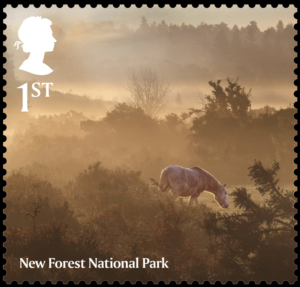 The New Forest is actually very old: it was created as a hunting forest almost a millennium ago by William the Conqueror, and centuries of use for grazing, timber and fuel have produced a landscape that is more of a mosaic of heathland, open pasture and ancient woodland dotted with mires and streams. Much of this area is not enclosed, meaning that ponies, donkeys and cattle owned by local people called Commoners roam freely. The National Park also has 42km of coastline, with spectacular views across to the Isle of Wight. The New Forest is a wonderful haven for wildlife and people alike.
The New Forest is actually very old: it was created as a hunting forest almost a millennium ago by William the Conqueror, and centuries of use for grazing, timber and fuel have produced a landscape that is more of a mosaic of heathland, open pasture and ancient woodland dotted with mires and streams. Much of this area is not enclosed, meaning that ponies, donkeys and cattle owned by local people called Commoners roam freely. The National Park also has 42km of coastline, with spectacular views across to the Isle of Wight. The New Forest is a wonderful haven for wildlife and people alike.
Lake District National Park
 William Wordsworth described the Lake District as “a sort of national property”. This could apply to all of the UK’s National Parks, but few can lay claim to as many hearts as this one. The ingredients of the landscape — a UNESCO World Heritage Site — include volcanic uproar 450 million years ago, the sculpting power of Ice Age glaciers and the much more recent handiwork of sheep farmers. For centuries now, the area has seduced visitors with the gentle pastoral ambience of its villages and valleys, the splendour of its lakes and the ruggedly sublime beauty of its fells. The obsession of the English Romantics with the Lake District helped crystallise the appeal of this iconic landscape.
William Wordsworth described the Lake District as “a sort of national property”. This could apply to all of the UK’s National Parks, but few can lay claim to as many hearts as this one. The ingredients of the landscape — a UNESCO World Heritage Site — include volcanic uproar 450 million years ago, the sculpting power of Ice Age glaciers and the much more recent handiwork of sheep farmers. For centuries now, the area has seduced visitors with the gentle pastoral ambience of its villages and valleys, the splendour of its lakes and the ruggedly sublime beauty of its fells. The obsession of the English Romantics with the Lake District helped crystallise the appeal of this iconic landscape.
Loch Lomond & The Trossachs National Park
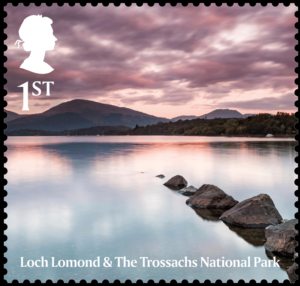 Bejewelled with emerald islands, fringed with beautiful wooded shores and surrounded by grand hills and mountains, Loch Lomond is where the Scottish Highlands ‘begin’. This National Park encloses 21 Munros (Scottish mountains above 3,000ft, or 914.4m) and includes some of the most popular mountains in Scotland, such as Ben Lomond — ‘Glasgow’s mountain’ — and the Cobbler, with a magnificent crown of rock on its summit. The Trossachs have been described as ‘the Highlands in miniature’, a compact and picturesque cluster of hills, lochs and pine forests. A network of water buses links points across Loch Lomond and Loch Katrine, providing a convenient way to explore the park by joining up foot and bike trails.
Bejewelled with emerald islands, fringed with beautiful wooded shores and surrounded by grand hills and mountains, Loch Lomond is where the Scottish Highlands ‘begin’. This National Park encloses 21 Munros (Scottish mountains above 3,000ft, or 914.4m) and includes some of the most popular mountains in Scotland, such as Ben Lomond — ‘Glasgow’s mountain’ — and the Cobbler, with a magnificent crown of rock on its summit. The Trossachs have been described as ‘the Highlands in miniature’, a compact and picturesque cluster of hills, lochs and pine forests. A network of water buses links points across Loch Lomond and Loch Katrine, providing a convenient way to explore the park by joining up foot and bike trails.
Snowdonia National Park
 The mountain that gives the Snowdonia National Park its name is its star attraction. Wales’s highest mountain — Yr Wyddfa in Welsh — is a complex massif of bristling ridges and pyramid-shaped summits, inhabited by agile mountain goats and the elusive Snowdon beetle. With almost half a million visitors a year, Snowdon ranks as one of the busiest mountains in the world, but hikers also flock to the Glyderau, with its pulse-racing scrambles, and the awesome Cader Idris. Legend holds that if you sleep on the slopes of the latter, you will die, go insane or turn into a poet. Numerous attractions such as surf parks, zip wires and underground adventures pull in thrill-seekers from far and wide.
The mountain that gives the Snowdonia National Park its name is its star attraction. Wales’s highest mountain — Yr Wyddfa in Welsh — is a complex massif of bristling ridges and pyramid-shaped summits, inhabited by agile mountain goats and the elusive Snowdon beetle. With almost half a million visitors a year, Snowdon ranks as one of the busiest mountains in the world, but hikers also flock to the Glyderau, with its pulse-racing scrambles, and the awesome Cader Idris. Legend holds that if you sleep on the slopes of the latter, you will die, go insane or turn into a poet. Numerous attractions such as surf parks, zip wires and underground adventures pull in thrill-seekers from far and wide.
North York Moors National Park
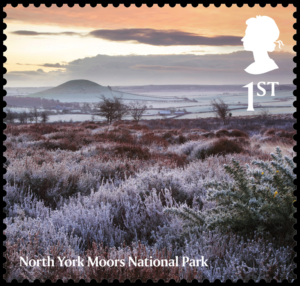 Endless seas of bright-purple moorland, steam trains puffing through sinuous valleys, sun-dappled waterfalls in lush woodland, the smell of fish and chips wafting through fishing villages in coastal coves…the North York Moors National Park has a timeless and idyllic feel, particularly in summer, with its retro-seeming villages and heritage railways — famously used as filming locations for Heartbeat and Harry Potter — evoking the atmosphere of a bygone era. Walking, cycling and sightseeing are the order of the day here, either in the valleys and moorland of the National Park’s interior or on its spectacular coastline — a sweep of high cliffs, hidden coves and rocky beaches, some of which are studded with Jurassic fossils and dinosaur footprints.
Endless seas of bright-purple moorland, steam trains puffing through sinuous valleys, sun-dappled waterfalls in lush woodland, the smell of fish and chips wafting through fishing villages in coastal coves…the North York Moors National Park has a timeless and idyllic feel, particularly in summer, with its retro-seeming villages and heritage railways — famously used as filming locations for Heartbeat and Harry Potter — evoking the atmosphere of a bygone era. Walking, cycling and sightseeing are the order of the day here, either in the valleys and moorland of the National Park’s interior or on its spectacular coastline — a sweep of high cliffs, hidden coves and rocky beaches, some of which are studded with Jurassic fossils and dinosaur footprints.
South Downs National Park
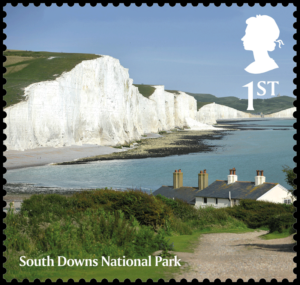 The South Downs National Park is the UK’s youngest, created in 2010. As well as incorporating the rolling chalk hills and white coastal cliffs of the South Downs themselves, it includes the wooded patchwork of the western Weald. Lying between London and the south coast, this is no remote wilderness, but walking through the landscape of gentle hills, ancient woods, sunken lanes and vineyards (vine-growing in this part of England dates back to at least Norman times) is a much-needed antidote to city stresses. This is also the easiest National Park to explore by public transport; the whole South Downs Way can be split into sections and accessed by bus and train.
The South Downs National Park is the UK’s youngest, created in 2010. As well as incorporating the rolling chalk hills and white coastal cliffs of the South Downs themselves, it includes the wooded patchwork of the western Weald. Lying between London and the south coast, this is no remote wilderness, but walking through the landscape of gentle hills, ancient woods, sunken lanes and vineyards (vine-growing in this part of England dates back to at least Norman times) is a much-needed antidote to city stresses. This is also the easiest National Park to explore by public transport; the whole South Downs Way can be split into sections and accessed by bus and train.
Peak District National Park
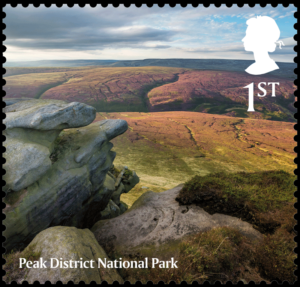 The Peak District is really two landscapes in one: the high moorland and Millstone Grit escarpments of the Dark Peak and the sleepy villages and lush limestone gorges of the White Peak. Its location at the heart of industrial England ensured that it was the crucible of the ‘right to roam’ movement. For workers from Manchester, the Potteries or the steel cities and wool towns of Yorkshire, the big boggy moors, peaceful valleys and climbing crags were the closest source of natural beauty and adventure. It is fitting that, in 1951, it became the first region in the UK to be granted National Park status. Today, around 20 million people live within an hour’s drive.
The Peak District is really two landscapes in one: the high moorland and Millstone Grit escarpments of the Dark Peak and the sleepy villages and lush limestone gorges of the White Peak. Its location at the heart of industrial England ensured that it was the crucible of the ‘right to roam’ movement. For workers from Manchester, the Potteries or the steel cities and wool towns of Yorkshire, the big boggy moors, peaceful valleys and climbing crags were the closest source of natural beauty and adventure. It is fitting that, in 1951, it became the first region in the UK to be granted National Park status. Today, around 20 million people live within an hour’s drive.
Pembrokeshire Coast National Park
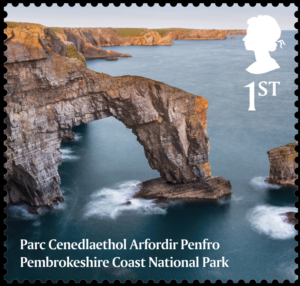 Pastel-coloured fishing villages hunkered in turquoise bays; long lines of surf rolling up to broad, white beaches; rugged cliffs, sea stacks, rock arches, bird colonies… This is the only UK National Park created primarily for the beauty of its coast — a spectacular Atlantic-battered shoreline. It is an exhilarating place to hike, surf, climb, go coasteering or ride out on a boat trip to the offshore islands and spot puffins, dolphins and seals. The hills and headlands are also dotted with stunning Neolithic burial chambers such as Pentre Ifan, Carreg Samson and Carreg Coetan Arthur, with huge slabs of rock balanced on top of each other at extraordinary angles.
Pastel-coloured fishing villages hunkered in turquoise bays; long lines of surf rolling up to broad, white beaches; rugged cliffs, sea stacks, rock arches, bird colonies… This is the only UK National Park created primarily for the beauty of its coast — a spectacular Atlantic-battered shoreline. It is an exhilarating place to hike, surf, climb, go coasteering or ride out on a boat trip to the offshore islands and spot puffins, dolphins and seals. The hills and headlands are also dotted with stunning Neolithic burial chambers such as Pentre Ifan, Carreg Samson and Carreg Coetan Arthur, with huge slabs of rock balanced on top of each other at extraordinary angles.
Broads National Park
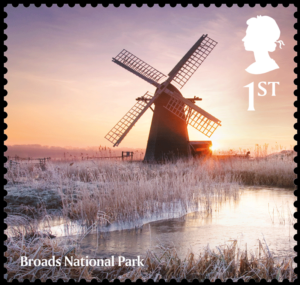 All of the UK’s National Parks are shaped by the hand of humanity in some way, but few as fundamentally as this one: the collection of lakes known as the Broads was formed by medieval peat diggings, later flooded as sea levels rose. Today, it is a labyrinth of over 200km of navigable waterways, criss-crossing a sleepy landscape dotted with picturesque pubs and villages — an idyllic water world to explore by boat. A vibrant wetland habitat, the park is home to a quarter of the UK’s rarest wildlife species. Otters dive around the riverbanks, the surreal boom of bitterns reverberates for miles and vast flocks of birds soar over the marshes.
All of the UK’s National Parks are shaped by the hand of humanity in some way, but few as fundamentally as this one: the collection of lakes known as the Broads was formed by medieval peat diggings, later flooded as sea levels rose. Today, it is a labyrinth of over 200km of navigable waterways, criss-crossing a sleepy landscape dotted with picturesque pubs and villages — an idyllic water world to explore by boat. A vibrant wetland habitat, the park is home to a quarter of the UK’s rarest wildlife species. Otters dive around the riverbanks, the surreal boom of bitterns reverberates for miles and vast flocks of birds soar over the marshes.
Philatelic Products:
Product name / Code / Price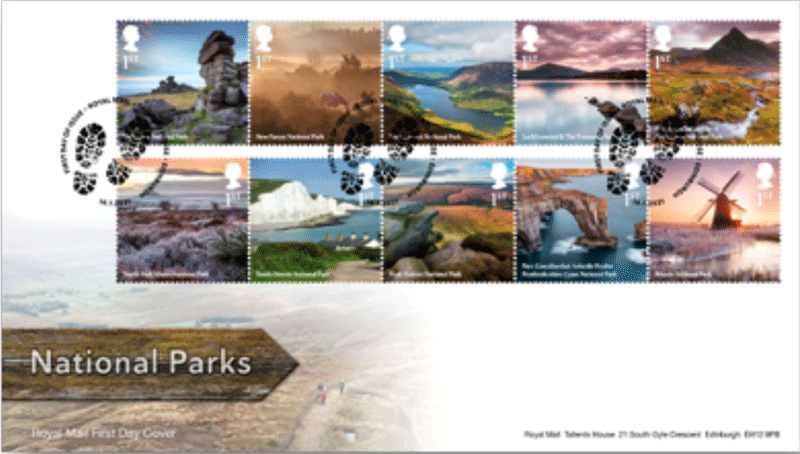 Stamp set AS6700 £8.50
Stamp set AS6700 £8.50
Presentation Pack AP484 £9.40
First Day Cover Stamps AF468 £10.85
Stamp Souvenir AW177 £10.85
First Day Envelope AE423 £0.30
Postcards AQ300 £4.50
Framed Stamps N3245 £29.99
Retail Stamp Book UB440 £5.10
Technical Specifications:
Feature: Type/Detail
Number of stamps: 10
Value of Stamps: 10 x 1st
(2 rows of Horizonal 5)
Design: Studio Mean
Acknowledgements: Dartmoor National Park © Andrew Ray/Getty Images; New Forest National Park © Photokes/Alamy Stock Photo; Lake District
National Park © Pablo Fernandez/Alamy Stock Photo; Loch Lomond & The Trossachs National Park © Richard Burdon/Alamy Stock Photo; Snowdonia National Park © Andrew Ray/500px/Getty
Images; North York Moors National Park © Stephen Street/Alamy Stock Photo; South Downs National Park © Peter Cripps/Alamy Stock Photo; Peak District National Park © RA Kearton/Getty
Images; Pembrokeshire Coast National Park © Gareth Spiller/EyeEm/Getty Images; Broads National Park © Chris Herring; a special thank-you to National Parks UK
Stamp Format: Over-square landscape
Stamp Size: 36.5mm (w) x 34.7mm (h)
Printer: International Security Printers
Print Process: Lithography
Perforations: 14.0 x 14.5
Phosphor: Bars as appropriate
Gum: PVA

 OTTAWA – As spectacular as the celebration itself, a special set of Lunar New Year stamps was issued today, ushering in the Year of the Ox with a retrospective collection of all 24 colourful stamp designs from the past 12 years.
OTTAWA – As spectacular as the celebration itself, a special set of Lunar New Year stamps was issued today, ushering in the Year of the Ox with a retrospective collection of all 24 colourful stamp designs from the past 12 years. [en Francais]
[en Francais]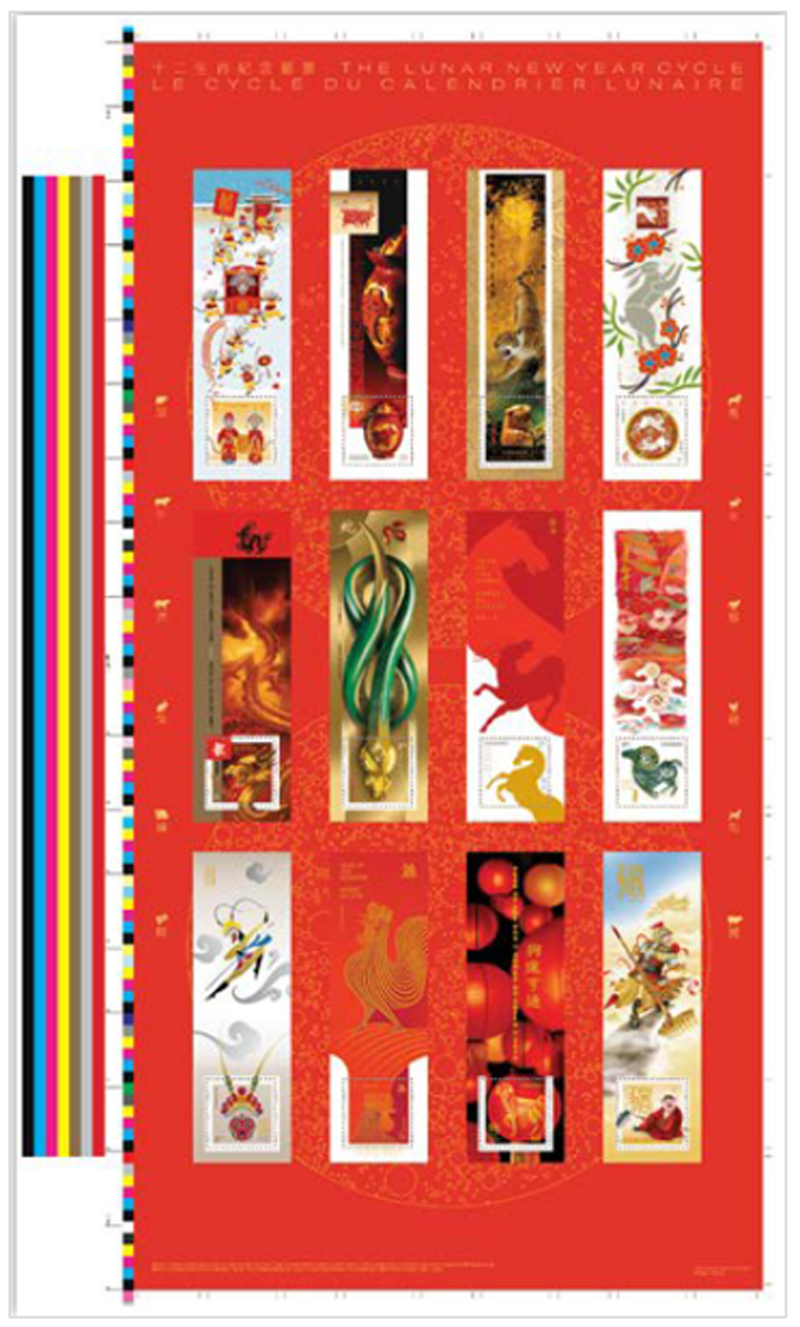 Each of the souvenir sheets will represent the current international rate of $2.71.
Each of the souvenir sheets will represent the current international rate of $2.71.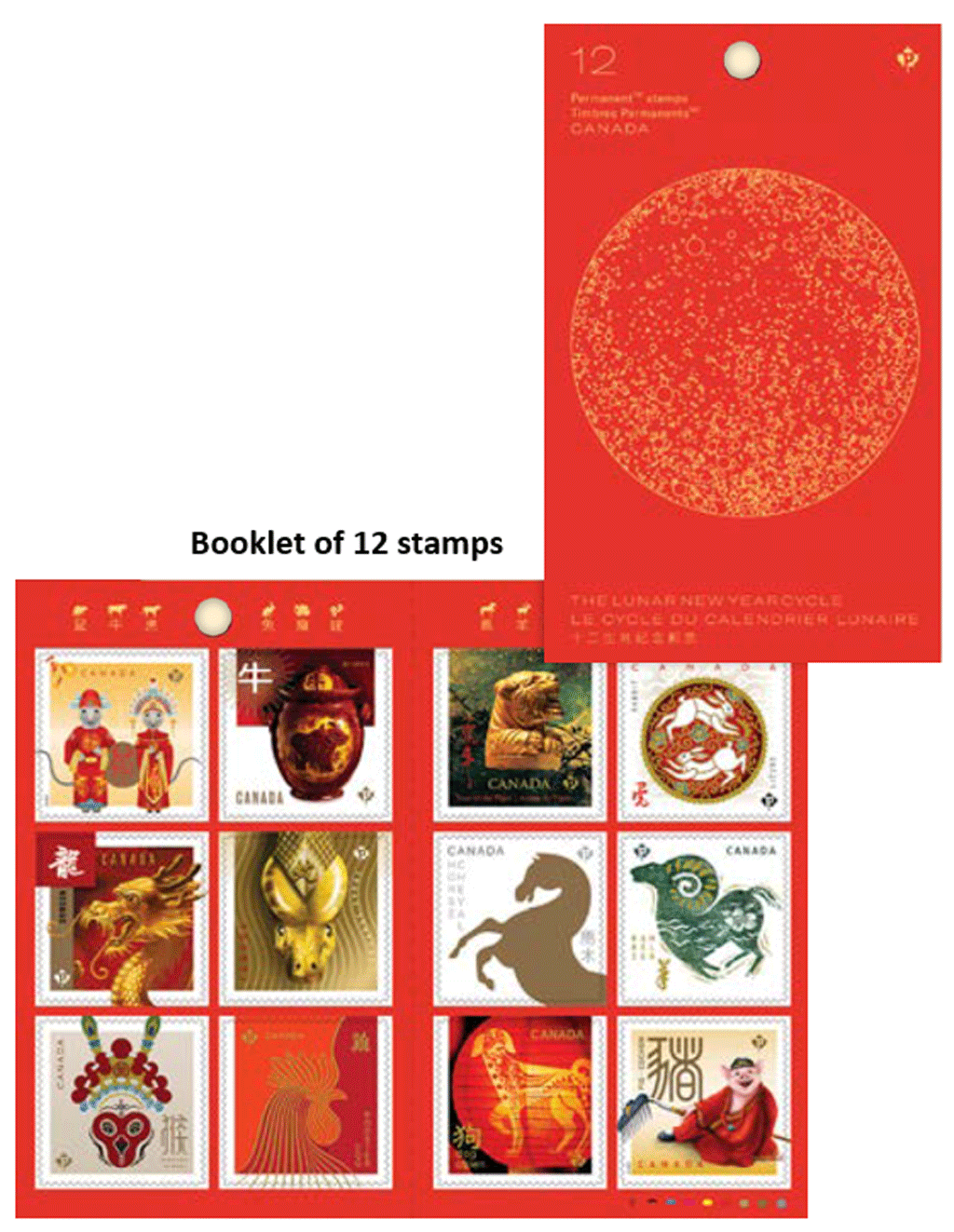 And a pane of 12 domestic-rate stamps will use the domestic-rate designs from 2009-2020.
And a pane of 12 domestic-rate stamps will use the domestic-rate designs from 2009-2020.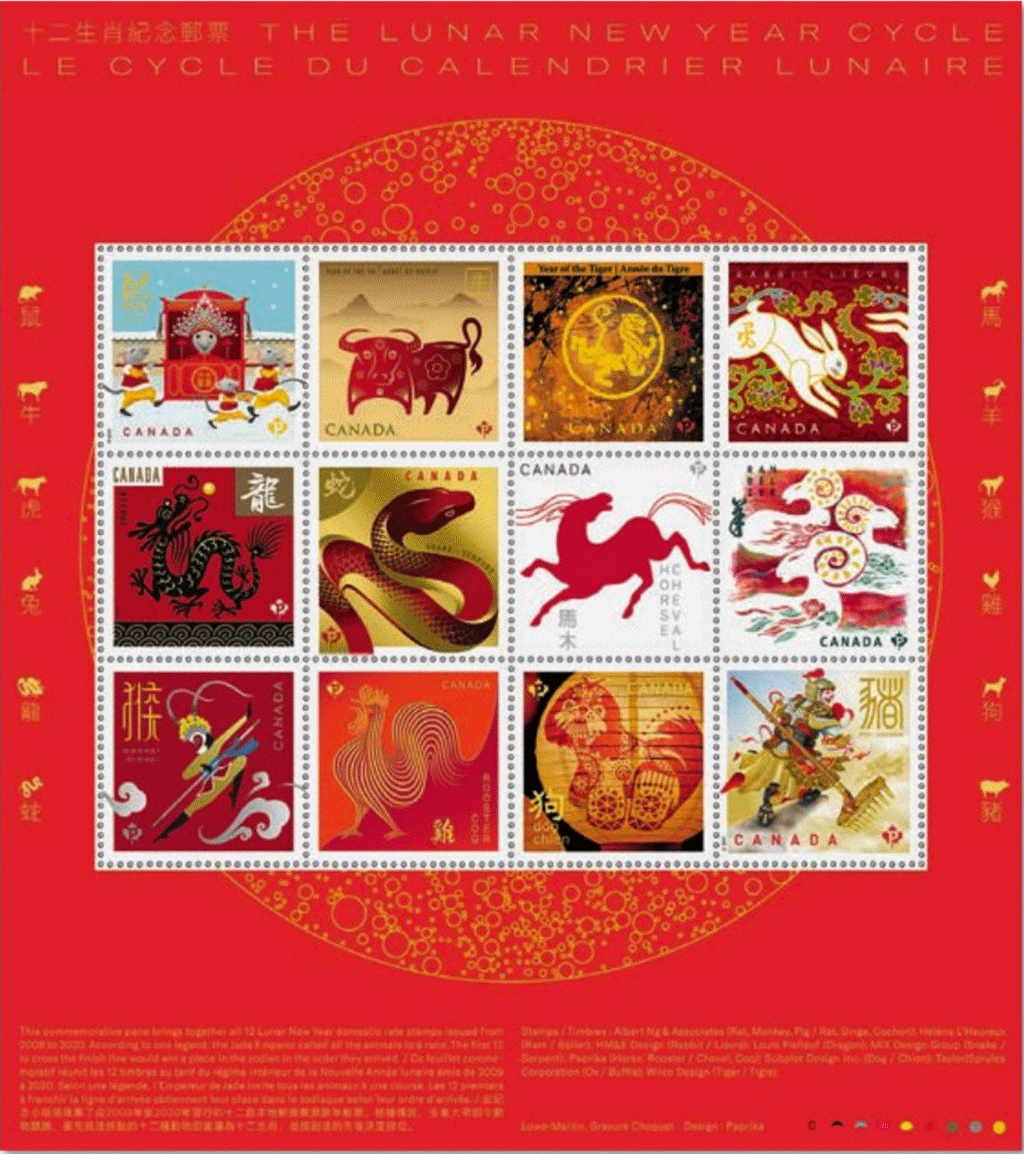 These stamps will be water-activated (“lick ‘n stick”).
These stamps will be water-activated (“lick ‘n stick”).
 and to seek out wanted items.
and to seek out wanted items.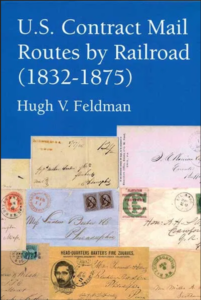 at a nominal cost by the collector or dealer (
at a nominal cost by the collector or dealer (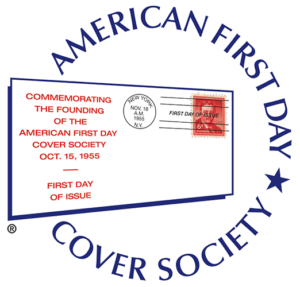 Members of the American First Day Cover Society, the largest not-for-profit organization in the world specifically for FDC collectors, have elected six people to its Board of Directors. The 279 ballots cast this year was much larger than usual, more than double the number in 2019.
Members of the American First Day Cover Society, the largest not-for-profit organization in the world specifically for FDC collectors, have elected six people to its Board of Directors. The 279 ballots cast this year was much larger than usual, more than double the number in 2019. Board chairman Cynthia Scott and President Lloyd de Vries thanked Elections Committee chair Otto Thamasett and committee members Neal Parr and Jack Ginsburg, all members of the Robert C. Graebner Chapter of the AFDCS, for their work in counting the ballots in this year’s election, and the Nominating Committee chaired by Michael Litvak for recruiting the candidates.
Board chairman Cynthia Scott and President Lloyd de Vries thanked Elections Committee chair Otto Thamasett and committee members Neal Parr and Jack Ginsburg, all members of the Robert C. Graebner Chapter of the AFDCS, for their work in counting the ballots in this year’s election, and the Nominating Committee chaired by Michael Litvak for recruiting the candidates.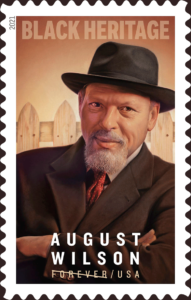 WASHINGTON, DC — Award-winning playwright August Wilson is receiving one of the nation’s highest honors when he takes center stage on a Forever stamp.
WASHINGTON, DC — Award-winning playwright August Wilson is receiving one of the nation’s highest honors when he takes center stage on a Forever stamp.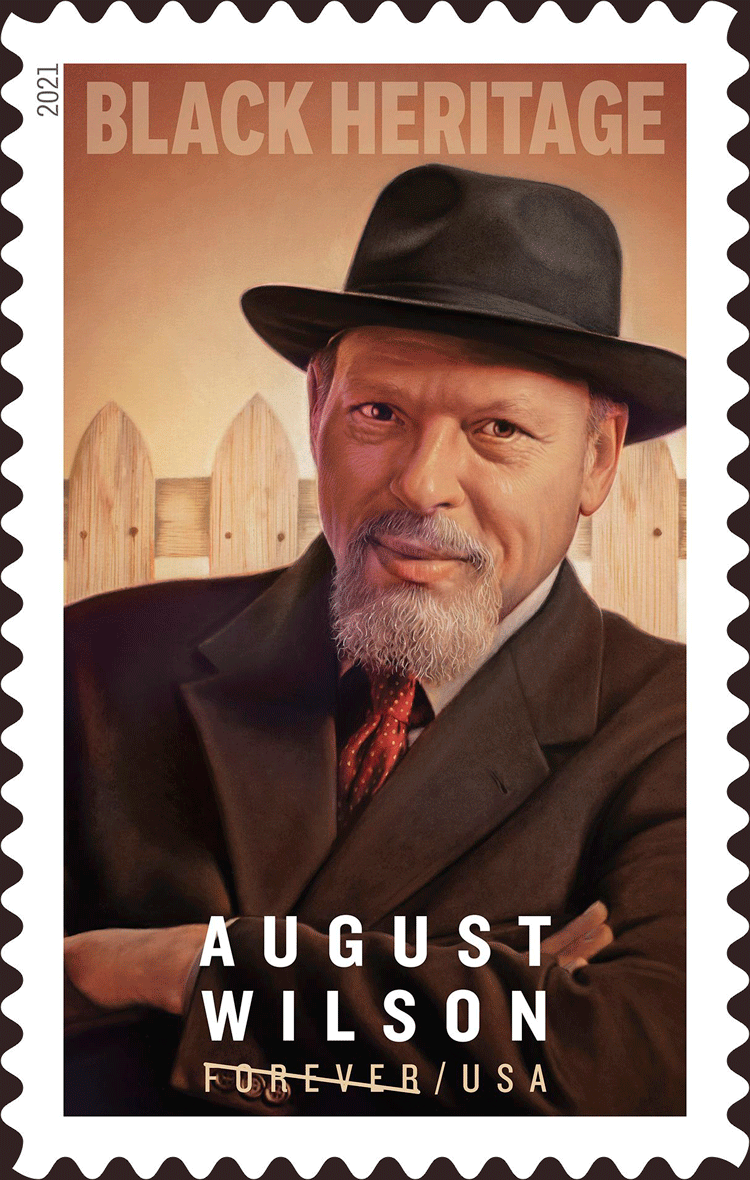
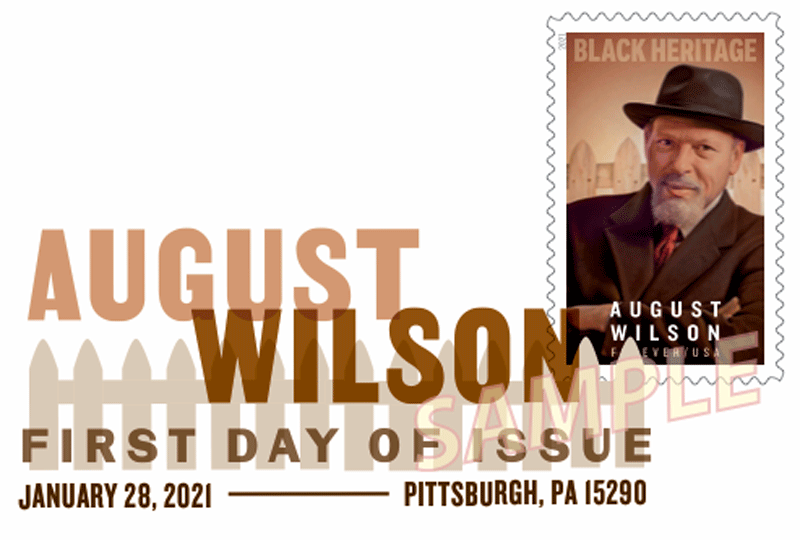 The Digital Color Postmark measures 2.70″ x 1.19″
The Digital Color Postmark measures 2.70″ x 1.19″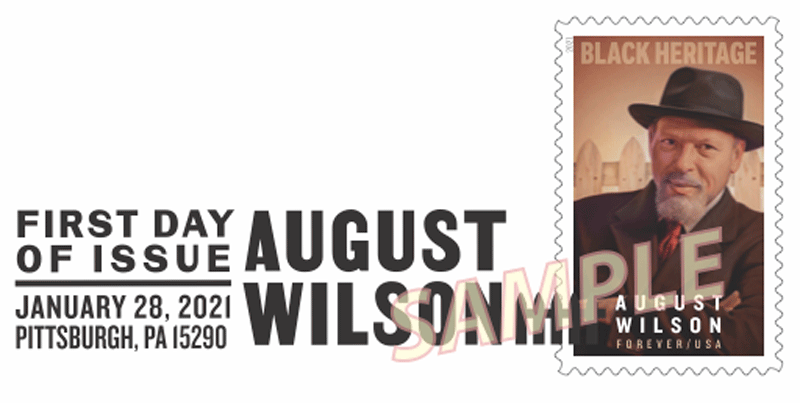 The B&W pictorial postmark measures 2.62″ x .63″
The B&W pictorial postmark measures 2.62″ x .63″ 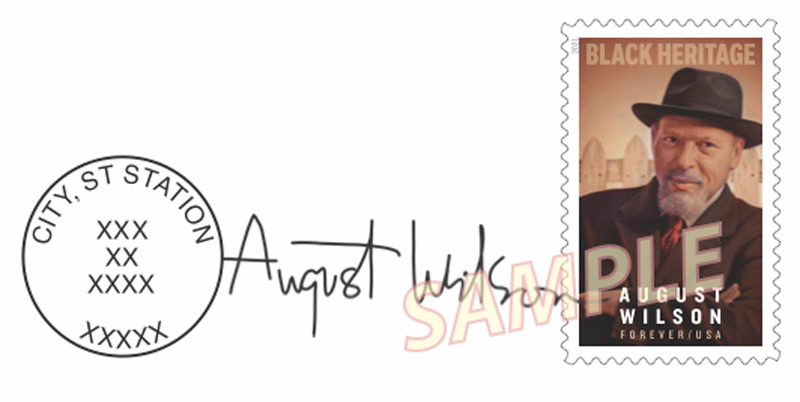 The special postmark, for use by other post offices, measures 2.71″ x .94″
The special postmark, for use by other post offices, measures 2.71″ x .94″